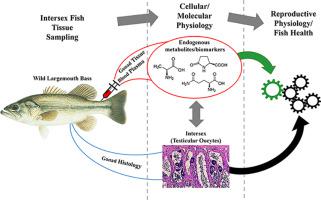Comparative Biochemistry and Physiology B: Biochemistry & Molecular Biology ( IF 2.2 ) Pub Date : 2020-08-19 , DOI: 10.1016/j.cbpb.2020.110491 Matthew L Urich 1 , W Matthew Henderson 2 , Alexander H MacLeod 3 , Lance T Yonkos 3 , Robert B Bringolf 1

|
Adverse reproductive effects associated with gonadal intersex among freshwater fish could hold considerable implications for population sustainability. Presence of testicular oocytes (TO) is the most common form of intersex and is widespread among centrarchids (sunfishes) of North America and other freshwater teleosts. Placing TO within the toxicological context of adverse outcome pathways (AOPs) to assess ecological risk is a priority for ecotoxicologists due to the association of TO with harmful chemical exposure and adverse reproductive effects in some cases. However, key event relationships between EDC exposure, incidence of TO, and apical outcomes have yet to be fully elucidated – in part due to a lack of knowledge of relationships between intersex gonad physiology and fish health. Understanding the physiological status of intersex fish is critical to assess ecological risk, understand mechanisms of induction, and to establish biomarkers of intersex in fish. In the present study, features of gonad metabolite profiles associated with TO in largemouth bass (LMB, Micropterus salmoides) from an impoundment in Georgia (USA) were determined using GC–MS-based metabolomics. Clinical blood biochemical screens were used to evaluate markers of fish health associated with TO. Results suggest that physiological changes in energy expenditure as well as relatively ‘feminized’ gonad lipid and protein metabolism may be related to the occurrence of TO in male LMB, and highlight the need to understand relationships between intersex and physical stressors such as elevated temperature and hypoxia. These results provide novel insight to AOPs associated with TO and identify candidate analytes for biomarker discovery.
中文翻译:

性腺代谢组学和血液生化分析揭示了与野生大嘴鲈 (Micropterus salmoides) 睾丸卵母细胞相关的差异。
与淡水鱼性腺间性相关的不良生殖影响可能对种群可持续性产生重大影响。睾丸卵母细胞 (TO) 的存在是最常见的双性动物形式,在北美和其他淡水硬骨鱼中广泛存在。将 TO 置于不利结果途径 (AOP) 的毒理学背景中以评估生态风险是生态毒理学家的优先事项,因为在某些情况下 TO 与有害化学物质暴露和不良生殖影响有关。然而,EDC 暴露、TO 发生率和顶端结果之间的关键事件关系尚未完全阐明 - 部分原因是缺乏对双性性腺生理学与鱼类健康之间关系的了解。了解双性鱼的生理状态对于评估生态风险、了解诱导机制和建立鱼中双性鱼的生物标志物至关重要。在本研究中,与大嘴鲈鱼(LMB,使用基于 GC-MS 的代谢组学测定来自乔治亚州(美国)蓄水池的Micropterus salmoides 。临床血液生化筛查用于评估与 TO 相关的鱼类健康标志物。结果表明,能量消耗的生理变化以及相对“女性化”的性腺脂质和蛋白质代谢可能与男性 LMB 中 TO 的发生有关,并强调需要了解双性人与身体压力因素(如高温和缺氧)之间的关系. 这些结果为与 TO 相关的 AOP 提供了新的见解,并确定了用于生物标志物发现的候选分析物。



























 京公网安备 11010802027423号
京公网安备 11010802027423号